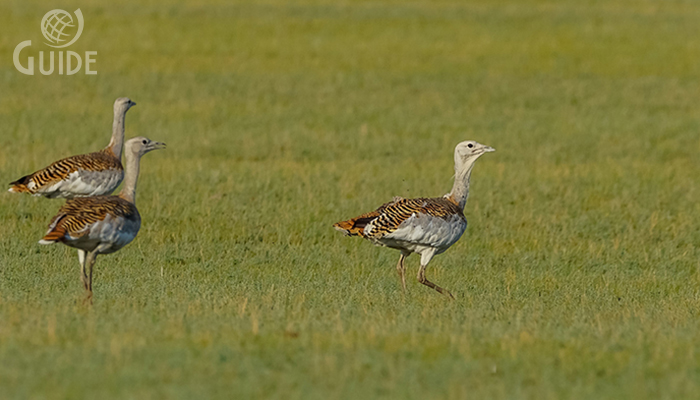
English: Great
Bustard
Russian: Дрофа
German: Grosstrappe
French: Outarde
barbue
Mongolian: Хонин тоодог
Japanese: ノガン (Nogan)
Body length: 75-105 cm
Wing span: 170-260 cm
Breeding visitor/ partial
migrant
Breeding season: May-August
Egg number: 4 (occasionally 3,
5)
Egg colour: Brownish-buff with
small black spots, blotches.
Brood: 1 per year
Food: Seeds, leaves, flowers,
wheat grains, insects, lizards,and frogs.
Status: Rare species. According to the IUCN Red List categories and
criteria,the species evaluated as – Vulnerable.
Distribution and Range: Once widely distributed on Mongolian steppes, the species were
sighted in small numbers in open spaces of the Dornod, Khentii, Sukhbaatar,
Tov, Khangai, Bulgan, Selenge, Zavkhan and Uvs Aimags. Used to winter in
Jargalant of Tov Aimag and occasionally near the Lag Lake in Dornod Aimag. In
recent years, the species winter on agricultural fields of the Eg, Tarbagatai,
Tarialan, Erdene, Bulgan soums in small groups from 20-to 100 individuals.
Habitat: Mongolian open steppes, river valleys, meadows, forest edge
steppe and wheat fields in winter.
Population and Threats: Population not assessed. Threats: habitat degradation due to
livestock grazing in the breeding sites, cutting grass, cultivating, loss of
food supply due to chemicals, fire hazards, dzud and poaching, close to persishing
due to natural and anthropogenic factors. Chicks are preyed upon birds of prey,
foxes, wild fox, wolves, dogs. Desease transmitted by parasites.
Conservation Measures: Hunting prohibited since 1980. Included as Rare animal in the
Annex to the Mongolian Government Resolution #7 (2012), included in the CITES,
Annex II and the Russian Red Data Book, the Mongolian Red Book. (1987, 1997).
Further actions: Develop protection measures based on the distribution, population
abundance, reproductive biology and ecology research, include the wintering
habitat within the NSPAN, restore natural resources through captive breeding.